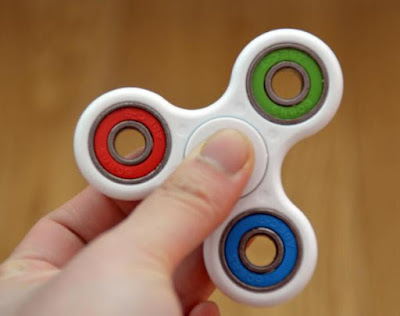Many spinners are marketed as aides for individuals with anxiety, autism and ADHD; Cppslee's spinner marketing patter on Amazon, for example, promises greater concentration for people with those conditions, plus an opportunity to "bring out that creative genius lying deep within you." [Why Fidget Spinners Are So Hot (and Where to Buy Them)]
Unsurprisingly, these claims are probably overblown, scientists say.
"Using a spinner-like gadget is more likely to serve as a distraction than a benefit for individuals with ADHD," said Mark Rapport, a clinical psychologist at the University of Central Florida who has studied the benefits of movement on attention in people with ADHD.
(The so-called fidget cube — which is a plastic cube equipped with various buttons and dials for fidgeting hands — may be more classroom friendly, according to a scientist who studies intersection of human computer interaction and games, who pointed out on the website The Conversation that the cube doesn't require visual attention. "They can serve the same purpose as the spinners, but are more classroom-ready and less distracting," Katherine Isbister, professor of Computational Media at the University of California, Santa Cruz, wrote on The Conversation.)
Regardless of their usefulness in keeping kids' distracted brains focused, fidget spinners have sparked a conversation about attention spans in kids and how to help the little ones focus, experts told Live Science. For instance, though there isn't a lot of data supporting the idea that kids have less focus today than in the past, some research does suggest attention spans have decreased as multitasking has increased with the digital age, one expert said. There are various methods for bringing kids' focus back to the lesson at hand, psychologists say, including fidgeting devices, activity breaks and the simple removal of extra distractions. (The devices may also teach kids something about physics, or at least ball bearings.)
Spinner benefits?
There's no doubt that toys that allow kids to fidget can benefit kids with autism. Occupational therapists often use sensory toys
like tactile discs, Koosh balls and even putties or clays to soothe
kids who have sensory-processing issues. Similarly, research has shown
that movement can help kids with ADHD to focus. A 2015 study published in the Journal of Abnormal Child Psychology
by Rapport and his colleagues looked at 8- to 12-year-old kids with
ADHD. The researchers found that those who participated in gross motor
activity — meaning the movement of limbs or large parts of the body —
performed better than those who sat still during tasks involving working
memory, which is a type of memory used for processing incoming
information. Exercise has also been proven to be helpful for kids with ADHD.But without studies that specifically look at fidget spinners, it's impossible to say for sure whether the devices could help kids with ADHD, Rapport told Live Science. He conjectured that the little handheld toys are not likely to help much. They don't require gross body movement, he said, which is what appears to be responsible for increasing activity in the frontal and prefrontal brain areas that are responsible for sustaining attention. The spinners are also visually distracting, and so they could pull a child's attention away from the chalkboard or teacher, Rapport said.
"Riding a stationary bike while reading, or sitting on a movement ball while working at one's desk, in contrast, allows small (non-distracting) motor movements and would probably prove beneficial for many children with ADHD," Rapport wrote in an email to Live Science.
Spinner safety
An unofficial report in June about possible lead in these toys may have
parents worried, but don't clear your home of the spinners just yet.
Tamara Rubin, a lead-poisoning-prevention advocate who is not affiliated
with any university or research institution, home-tested 11 fidget
spinners and found unusually high amounts of lead in two of these. Even
so, Rubin's findings have not been replicated nor peer-reviewed; and
Rubin only tested 11 spinners. A bigger concern may be the risk of kids choking on some of the spinner's small parts. The U.S. Consumer Product Safety Commission, is looking into reports of children choking on parts that have popped out of a fidget spinner, said Patty Davis, the CPSC's acting communications director.
Source: https://www.livescience.com/58916-fidget-spinner-faq.html


Our son was diagnosed ADD, just started high school. His tutor encouraged him to try doing his writing in the INK for All word processor. He can really get into his groove with it. All of the Advanced Accessibility features like the offline functionality are impressive. I wanted let other dads know about it here: http://bit.ly/2DWi1K9
ReplyDelete